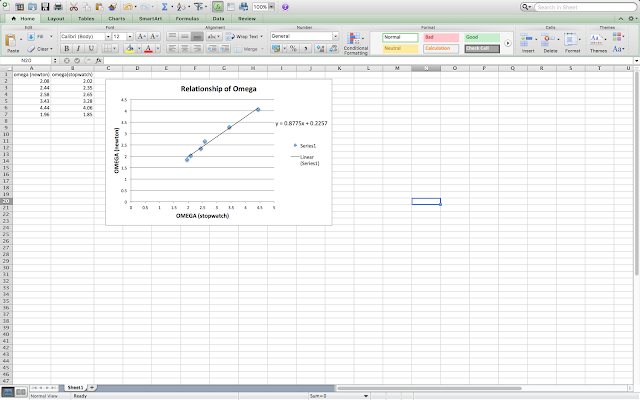Ballistic Pendulum
Samuel
Ellis
Mia
10-12-2016
Purpose:
Determine the firing speed of a ball from a spring-loaded gun.
Procedure:
1. Measure/record the mass of the ball and block
2. Level the base of the apparatus.
3. Make sure that the block is level.
4. Pull back and lock the spring into position(There are three possible "notches" you can pull back to. Record which notch you are using.) Place the ball into position. Put the angle indicator to zero degrees.
5. Fire the ball into the ball into the block and record maximum angle to which the block rises.
6. Repeat this a total of four or five to get an average.
(As the ballet fired into holder, the holder and ballet become in-elastically, which cause the momentum of the block to gain more energy. In which block accelerate upward until gravity pull it down. Since the metal pointer will stay wherever the block last appear. In can indicate what angle gravitational potential energy occur with sin or cos. So we can translate GPE into how much energy spring release.)
Data:
mass = 85.3 gram
b = 7.7 grams
theta = 21.0 +-0.5 = 0.367 rad
h = 19.2 cm +- 0.1
Second theta = 21 +-0.5 = 0.367 rad
Third theta = 21+- 0.5 = 0.367 rad
Forth theta = 21 +- 0.5 = 0.367 rad
d = 226 cm +- 26 cm
h = 98.5
Above is the equation we derived to solve for velocity of the ball. We first set kinetic energy equal to Gravitational Potential Energy, then isolate velocity. As result, I got 6.04 meter per second.
Conclusion:
This experiment is based on understanding of different kind of energy. We have to assume there are no additional force or energy acting on it. Then we can use energy transfer to find each individual energy. We first measure the angle ball was firing at(did 3 times and then average them out) then with already known mass and gravity, we are able to calculate gravitational potential energy of the block Which will equal to kinetic or spring energy. Based on given data, there are some uncertainty occur in the experiment. We have +- 0.1 for height and +- 0.5 for angle we measured. And according to our uncertainty equation, we got +-0.15 for velocity.







































